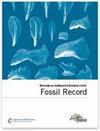下载PDF
{"title":"Skeletochronology and isotopic analysis of a captive individual of Alligator mississippiensis Daudin, 1802","authors":"Nicole Klein, Torsten Scheyer, Thomas Tütken","doi":"10.1002/mmng.200900002","DOIUrl":null,"url":null,"abstract":"<p>In the present study, bone histology and isotope composition (C, N, O) of a femur and three postcranial osteoderms from an approximately 23–25 year-old captive female <i>Alligator mississippiensis</i> Daudin, 1802 were analyzed to infer the recorded life history. The number of visible annual growth marks in the femur cross-section is less than the known age for the individual concerned, this information clearly shows that skeletochronology has certain limits. However, bone histology reflects very well the traceable life history of this individual and its slow growth in early ontogeny. Bone histology on the basis of the osteoderms shows massive remodeling and an only incompletely preserved growth record, reflecting the egg-laying status of this individual. Interestingly, the carbon and especially the nitrogen isotope compositions of the osteoderms differ from those of the femur. This presumably reflects dietary changes and/or differences in resorption and remodeling processes during tissue formation of these bones. The N, C, and O isotope composition of the femur is consistent with the food and water the alligator had ingested during the last years of its life. Thus, contrary to the osteoderms, the femur yields reliable data for the reconstruction of an individual's dietary and environmental history. (© 2009 WILEY-VCH Verlag GmbH & Co. KGaA, Weinheim)</p>","PeriodicalId":55147,"journal":{"name":"Fossil Record","volume":"12 2","pages":"121-131"},"PeriodicalIF":1.4000,"publicationDate":"2009-08-03","publicationTypes":"Journal Article","fieldsOfStudy":null,"isOpenAccess":false,"openAccessPdf":"https://sci-hub-pdf.com/10.1002/mmng.200900002","citationCount":"63","resultStr":null,"platform":"Semanticscholar","paperid":null,"PeriodicalName":"Fossil Record","FirstCategoryId":"89","ListUrlMain":"https://onlinelibrary.wiley.com/doi/10.1002/mmng.200900002","RegionNum":4,"RegionCategory":"地球科学","ArticlePicture":[],"TitleCN":null,"AbstractTextCN":null,"PMCID":null,"EPubDate":"","PubModel":"","JCR":"Q3","JCRName":"Earth and Planetary Sciences","Score":null,"Total":0}
引用次数: 63
引用
批量引用
Abstract
In the present study, bone histology and isotope composition (C, N, O) of a femur and three postcranial osteoderms from an approximately 23–25 year-old captive female Alligator mississippiensis Daudin, 1802 were analyzed to infer the recorded life history. The number of visible annual growth marks in the femur cross-section is less than the known age for the individual concerned, this information clearly shows that skeletochronology has certain limits. However, bone histology reflects very well the traceable life history of this individual and its slow growth in early ontogeny. Bone histology on the basis of the osteoderms shows massive remodeling and an only incompletely preserved growth record, reflecting the egg-laying status of this individual. Interestingly, the carbon and especially the nitrogen isotope compositions of the osteoderms differ from those of the femur. This presumably reflects dietary changes and/or differences in resorption and remodeling processes during tissue formation of these bones. The N, C, and O isotope composition of the femur is consistent with the food and water the alligator had ingested during the last years of its life. Thus, contrary to the osteoderms, the femur yields reliable data for the reconstruction of an individual's dietary and environmental history. (© 2009 WILEY-VCH Verlag GmbH & Co. KGaA, Weinheim)
1802年一只圈养鳄鱼的骨骼年代学和同位素分析
在本研究中,我们分析了一只大约23-25岁的雌性密西西比鳄(Daudin, 1802)的股骨和三个颅后骨皮的骨组织学和同位素组成(C, N, O),以推断其记录的生活史。股骨横截面上可见的年生长标记的数量少于有关个体的已知年龄,这一信息清楚地表明骨骼年代学有一定的局限性。然而,骨组织学很好地反映了该个体的可追溯生活史及其在早期个体发育中的缓慢生长。基于骨皮的骨组织显示大量重塑和仅保存不完整的生长记录,反映了该个体的产卵状态。有趣的是,骨皮的碳同位素组成,尤其是氮同位素组成与股骨的不同。这可能反映了这些骨骼组织形成过程中饮食的变化和/或吸收和重塑过程的差异。股骨的N、C和O同位素组成与短吻鳄在生命的最后几年摄入的食物和水一致。因此,与骨皮细胞相反,股骨提供了重建个体饮食和环境历史的可靠数据。(©2009 WILEY-VCH Verlag GmbH &KGaA公司,Weinheim)
本文章由计算机程序翻译,如有差异,请以英文原文为准。


